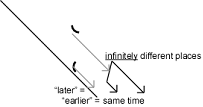


   |
| vehicle speed | distance between events | |
| 88.5 km/hour (0.0246 km/sec) | 7.38 km | |
| 42,000 km/sec | 12.7 million km | |
| 270,000 km/sec | 186 million km |
Note how the distance between events increases faster than the speed does. While 270,000 kilometers per second is less than seven times faster than 42,000 kilometers per second, 186 million kilometers is over 14 times further than 12.7 million kilometers.
This is rather different from what we would ordinarily expect. In our usual experience, if you want to cover twice as much distance in a given amount of time, you have to go twice the speed. But the same relationship between space and time that makes events' time separation depend on velocity also affects how their space separation depends on velocity. The greater the velocity difference is between reference frames, the less conventional this dependence is.
From our conventional experience, we might reasonable expect that in order to put an infinite distance in finite time between our picking a phone up and putting it down, we'd have to travel infinitely fast. As it turns out, though, there's a finite speed that would serve the purpose.

| vehicle speed | distance between events | |
| 299,792.458 km/sec | ∞ |
This particular finite speed turns out to act as though it were infinite in another way. If you ran after something that was traveling infinitely fast, you could never overtake it. Infinite speed in one frame of reference would also be infinite in any other frame of reference. That, at least, is what we would expect if space and time weren't interrelated as the Minkowski diagram illustrates. But in fact, it is the finite speed of 299,792.458 kilometers per second that behaves this way. Start running after something that's traveling 299.792.458 kilometers per second, and you'll find that even in your new frame of reference, it's still pulling away from you at 299.792.458 kilometers per second-not at almost 299.792.458 kilometers per second, but at exactly 299,792.458 kilometers per second. Even if you were to take off at very close to that speed-say, 299,792.457 kilometers per second-you'd be no better off. You wouldn't reduce the speed difference to one meter per second. Because of how time itself changes between reference frames, in your new reference frame the object you were pursuing would still be getting away from you at exactly the same 299,792.458 kilometers per second that it was traveling in your original frame of reference.
299,792.458 kilometers per second, as it happens, is how fast light travels through a vacuum. (.....continued)


 |
Information
Bridge • Energy
Citations Database • E-print
Network • R&D
Accomplishments
About OSTI Science.gov • USA.gov • USAJOBS • Grants • Regulations.gov |
|---|